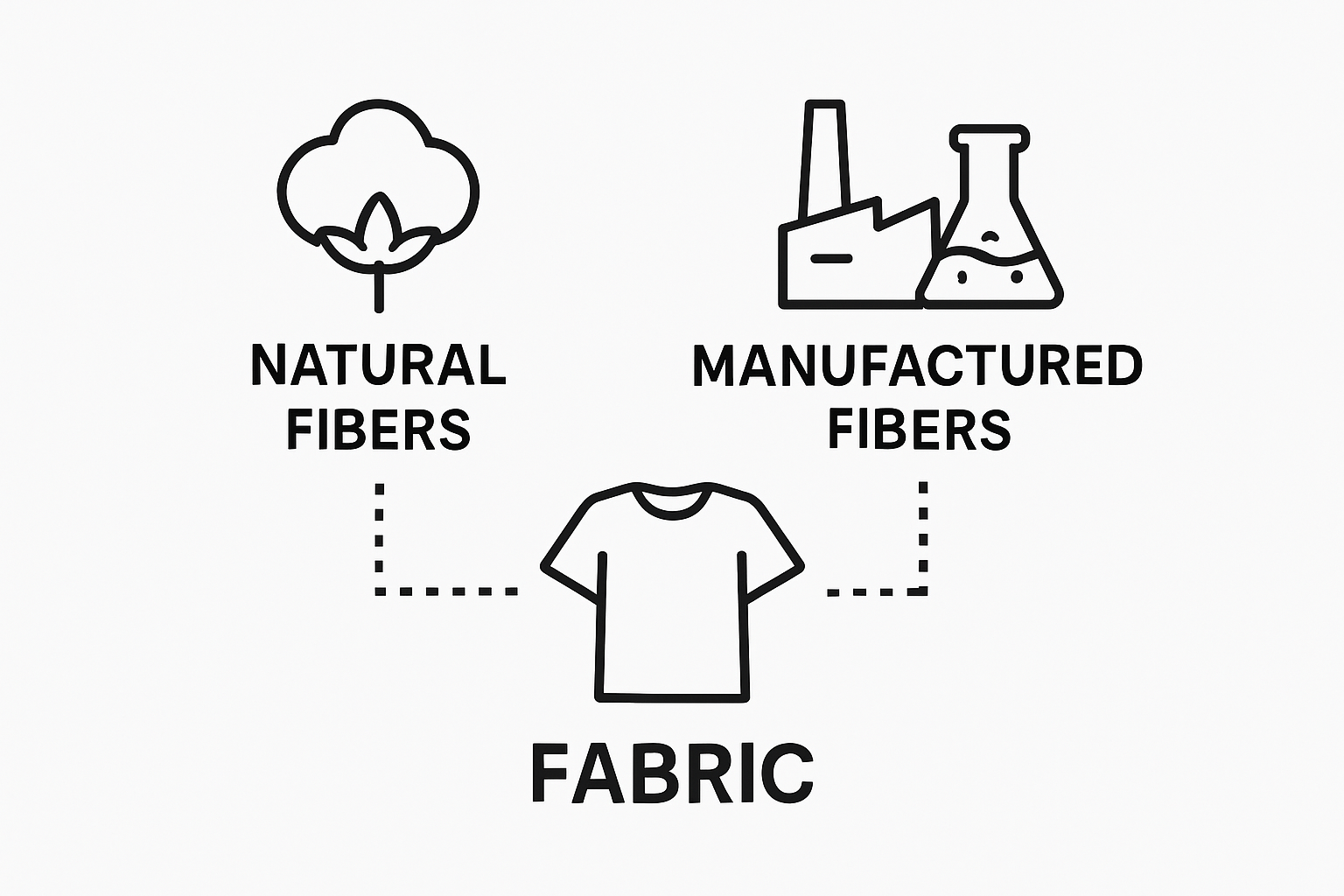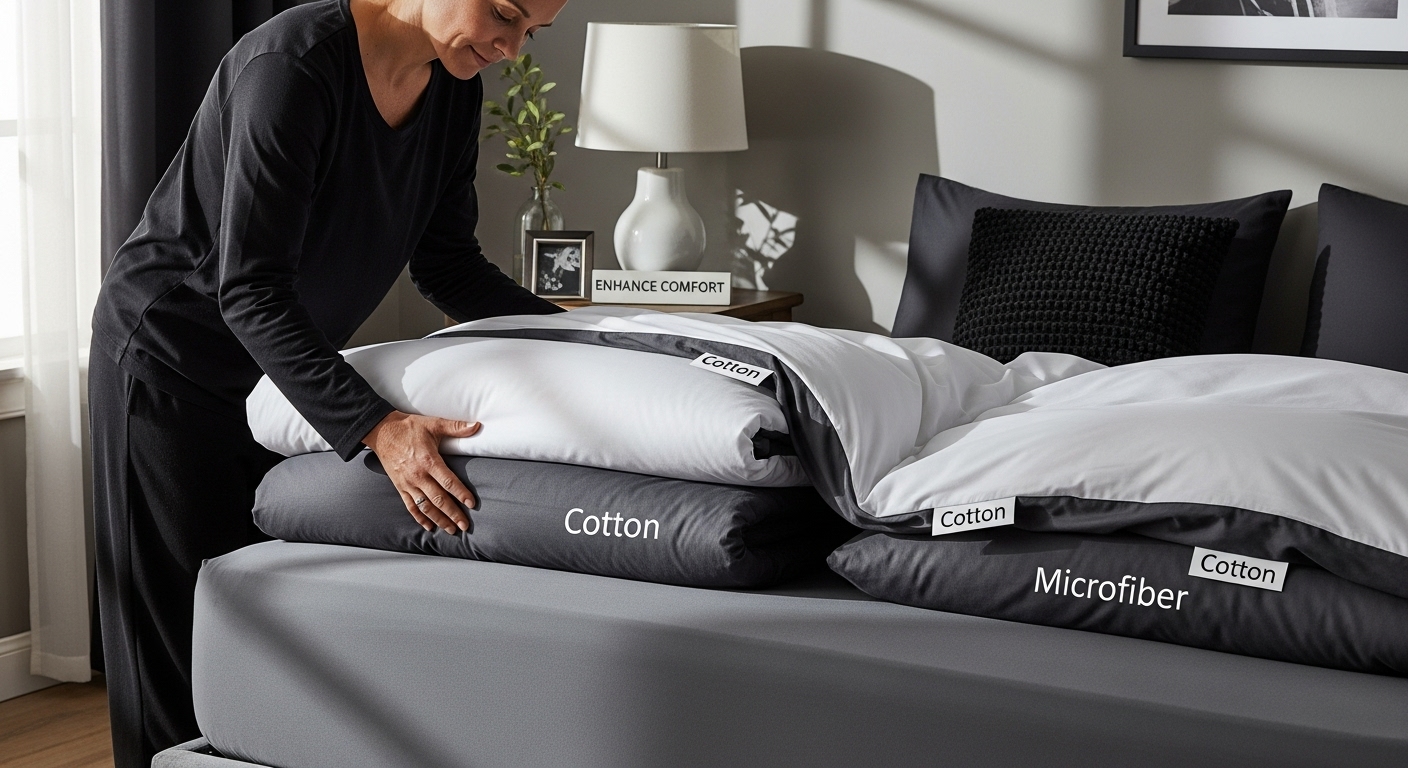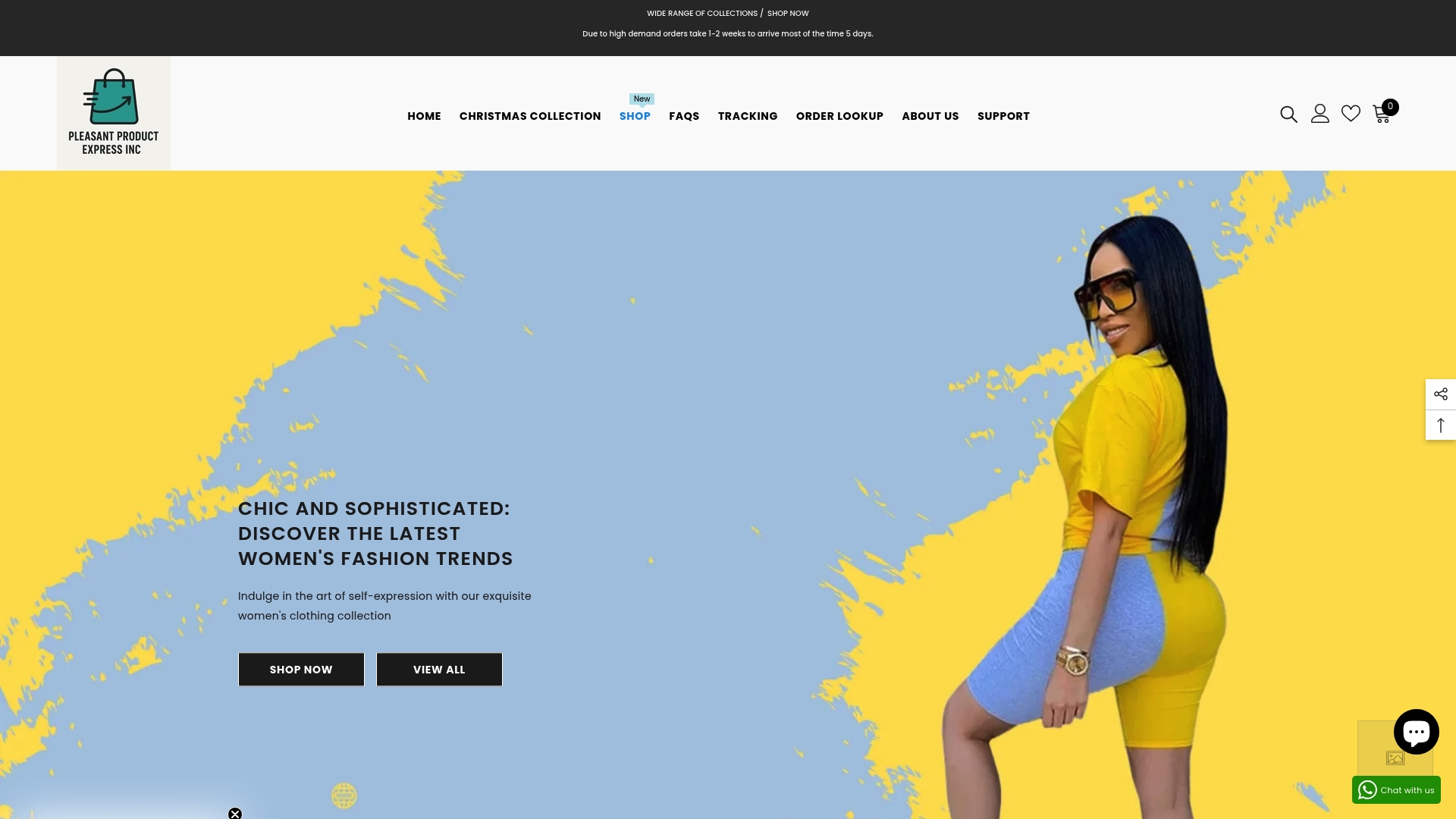Understanding the Role of Fabrics in Comfort
Fabrics do way more than just cover our bodies. Nearly everyone wears or uses textiles every single day, and yet most people overlook how much these materials actually impact well-being. Here is something that might surprise you. Performance textiles can control body temperature and wick away sweat faster than skin can naturally evaporate it. The real shock is that comfort from fabrics is not just about touch or softness but a complex mix of how our bodies and minds react to textile structure, fiber, and design. This changes everything about how we think of the clothes and materials all around us.
Table of Contents
- What Are Fabrics and Their Types?
- Why Fabrics Matter For Comfort
- How Fabrics Affect Body Temperature And Moisture
- Key Properties Of Fabrics That Enhance Comfort
- Real-World Applications: Fabrics In Everyday Life
Quick Summary
| Takeaway | Explanation |
|---|---|
| Choose fibers wisely | Natural fibers like cotton and wool enhance breathability and comfort, whereas synthetic fibers offer moisture management. |
| Understand fabric construction | Woven, knitted, and nonwoven methods affect fabric performance, durability, and comfort in clothing and textiles. |
| Consider thermal and moisture properties | Fabrics regulate body temperature and wick moisture away, influencing overall comfort during various activities. |
| Balance sensory and physiological comfort | The texture and feel of fabrics impact psychological well-being, influencing preferences in clothing choices. |
| Evaluate fabric suitability for environment | Different fabrics adapt to specific climates and activities, enhancing comfort and functional performance in daily life. |
What are Fabrics and Their Types?
Fabrics are versatile textile materials created by interlacing or interconnecting fibers, serving as fundamental components in clothing, home furnishings, and numerous industrial applications. The role of fabrics in comfort is deeply rooted in their composition, structure, and inherent properties.
Natural vs Manufactured Fibers
Fabrics are primarily derived from two major categories of fibers: natural and manufactured. According to Ohio State University Extension, natural fibers originate from organic sources and include:
- Cotton (from cotton plant)
- Wool (from sheep)
- Silk (from silkworm cocoons)
- Linen (from flax plant)
Manufactured fibers, in contrast, are synthetically produced through chemical processes. These include polyester, nylon, acrylic, and rayon. Each fiber type brings unique characteristics that significantly influence the fabric’s performance, comfort, and durability.
Below is a comparison table organizing the characteristics of natural versus manufactured fibers, summarizing how each impacts comfort, durability, and fabric performance.
| Fiber Type | Source | Key Comfort Properties | Common Uses |
|---|---|---|---|
| Cotton | Cotton plant | Highly breathable, soft, absorbs moisture | Shirts, bedding, casual wear |
| Wool | Sheep | Excellent insulation, retains warmth when damp, breathable | Sweaters, suits, blankets |
| Silk | Silkworm cocoon | Smooth texture, good moisture absorption, lightweight | Luxury apparel, scarves |
| Linen | Flax plant | Cool feel, very breathable, quick drying | Summer apparel, home textiles |
| Polyester | Synthetic | Strong moisture-wicking, durable, resists shrinking | Athletic wear, activewear |
| Nylon | Synthetic | Lightweight, stretchable, abrasion-resistant | Sportswear, hosiery, outerwear |
| Acrylic | Synthetic | Soft, warm, lightweight, resists moths | Sweaters, blankets, hats |
| Rayon | Regenerated cellulose | Smooth, drapes well, absorbent | Dresses, blouses, home textiles |

Fabric Construction Techniques
Encyclopaedia Britannica highlights three primary fabric construction methods that determine a textile’s comfort and functionality:
-
Woven Fabrics: Created by interlacing threads at right angles, providing structure and strength. Examples include denim, cotton shirts, and suit materials.
-
Knitted Fabrics: Formed by interlocking loops of yarn, offering stretch and flexibility. Common in t-shirts, sportswear, and underwear.
-
Nonwoven Fabrics: Produced by bonding fibers through mechanical, chemical, or thermal processes. Used in medical supplies, filters, and disposable products.
Understanding fabric types helps consumers make informed choices about clothing, bedding, and other textile products that directly impact personal comfort and performance.
The following table summarizes the main fabric construction techniques, highlighting their structural features and typical applications to help readers understand how construction affects comfort and function.
| Construction Technique | Structural Features | Common Products |
|---|---|---|
| Woven | Interlaced threads at right angles, structured | Denim, shirts, suits |
| Knitted | Interlocked yarn loops, stretchy and flexible | T-shirts, sportswear, underwear |
| Nonwoven | Bonded fibers (mechanical/chemical/thermal) | Medical supplies, filters, disposables |
Why Fabrics Matter for Comfort
Comfort is not just a luxury but a fundamental requirement in clothing and textile design. The role of fabrics in comfort goes far beyond mere aesthetics, encompassing complex physiological and psychological interactions between the human body and textile materials.
Physiological Performance of Fabrics
Research published in Polymers reveals that fabric comfort is a multidimensional experience involving intricate interactions between textile properties and human sensory perception. Key physiological factors that determine fabric comfort include:
- Thermal Regulation: Ability to manage body heat and maintain optimal temperature
- Moisture Management: Capacity to wick away sweat and maintain dryness
- Breathability: Allowing air circulation to prevent overheating
Different fabric compositions respond uniquely to these physiological demands. Natural fibers like cotton provide excellent breathability, while synthetic materials like polyester offer superior moisture-wicking capabilities.
Psychological Dimensions of Textile Comfort
Beyond physical performance, fabrics profoundly impact psychological comfort. Texture, softness, and sensory feedback contribute significantly to a person’s overall perception of comfort. The tactile experience of a fabric can influence mood, confidence, and emotional well-being.
Psychological comfort is why some people prefer soft cotton t-shirts for relaxation, while others might choose performance synthetics for athletic activities. Learn more about choosing comfortable clothing to understand these nuanced preferences.
Ultimately, the perfect fabric balances physiological performance with psychological satisfaction, creating a harmonious experience that makes clothing feel like a second skin.
How Fabrics Affect Body Temperature and Moisture
Fabrics play a crucial role in managing human body temperature and moisture, acting as a critical interface between our skin and the external environment. The complex interaction between textile materials and physiological processes determines our thermal comfort and overall sensory experience.
Thermal Insulation Mechanisms
According to the National Institutes of Health, fabric properties directly influence body temperature regulation through several key mechanisms:
- Air Trapping: Fabric structures create microscopic air pockets that provide insulation
- Heat Conductivity: Different fibers transfer heat at varying rates
- Moisture Transportation: Ability to move sweat away from skin surface
Natural fibers like wool and cotton excel at temperature management by creating effective air insulation layers. Wool, for instance, can retain warmth even when damp, while cotton provides breathable cooling in warm environments.
Moisture Management Dynamics
Moisture control is a critical aspect of thermal comfort. Synthetic and advanced fabrics have revolutionized how textiles handle perspiration and environmental humidity. Performance fabrics engineered with specialized technologies can:
- Rapidly wick moisture away from skin
- Accelerate evaporation rates
- Prevent fabric saturation
Performance textiles such as moisture-wicking athletic wear demonstrate how advanced fabric engineering can enhance personal comfort by managing body moisture more effectively than traditional materials.
Environmental Adaptation
The role of fabrics in comfort extends beyond individual garment performance. Different fabric compositions enable clothing to adapt to various environmental conditions, from humid tropical climates to dry, cold environments. By understanding fabric properties, individuals can select textiles that provide optimal temperature and moisture management for specific activities and settings.
Check out our guide on choosing comfortable clothing to learn more about selecting the right fabrics for different scenarios.
Key Properties of Fabrics That Enhance Comfort
Comfort in textiles is a sophisticated interplay of physical and sensory attributes that go beyond simple material selection. Understanding the nuanced properties that contribute to fabric comfort can help individuals make more informed clothing and textile choices.
Structural and Mechanical Properties
Research from the Journal of Textile and Apparel Technology and Management highlights several critical structural characteristics that determine fabric comfort:
- Thickness and Density: Impacts insulation and weight
- Elasticity: Determines fabric flexibility and movement
- Surface Texture: Influences tactile sensation against skin
Multilayered fabrics demonstrate how strategic design can enhance comfort by reducing pressure and improving moisture management. The intricate construction of these textiles allows for better temperature regulation and improved sensory experience.

Physiological Comfort Factors
Comfort is not just about how a fabric feels, but how it interacts with the human body. Key physiological comfort factors include:
- Air permeability
- Moisture-wicking capabilities
- Thermal conductivity
- Rapid drying properties
Performance fabrics engineered for specific activities showcase how advanced textile technology can optimize these physiological comfort parameters. For athletes and active individuals, these properties are crucial in maintaining comfort during intense physical activities.
Sensory and Psychological Comfort
Beyond physical properties, fabric comfort encompasses psychological dimensions. The way a fabric looks, feels, and moves can significantly impact a wearer’s emotional state and confidence. Learn more about adaptive clothing designs that prioritize both physical and psychological comfort.
Ultimately, the most comfortable fabrics harmonize technical performance with sensory satisfaction, creating a seamless and enjoyable wearing experience.
Real-World Applications: Fabrics in Everyday Life
Fabrics are not merely materials but functional solutions that address complex human needs across various domains of daily living. From clothing and home furnishings to specialized professional equipment, textile technologies play a pivotal role in enhancing comfort, performance, and quality of life.
Personal Clothing and Lifestyle
Research from the National Institutes of Health demonstrates how fabric selection impacts personal comfort in everyday scenarios. Different textiles serve unique purposes:
- Casual Wear: Breathable cotton for everyday comfort
- Professional Attire: Wrinkle-resistant synthetic blends
- Active Lifestyle: Moisture-wicking performance fabrics
- Sensitive Skin: Hypoallergenic and soft natural fibers
Temperature regulation becomes crucial in clothing selection. A lightweight linen shirt provides cooling in summer, while a dense wool sweater offers warmth during winter months. The right fabric can transform a mundane clothing item into a comfort-enhancing solution.
This table showcases how different fabric applications in daily life are matched with fabric types and comfort features, providing a practical reference for selecting fabrics for specific needs.
| Application Area | Recommended Fabric Types | Comfort Features Highlighted |
|---|---|---|
| Casual Wear | Cotton, linen, blended knits | Breathability, softness, ease of movement |
| Professional Attire | Synthetic blends, wrinkle-resistant fabrics | Structure, easy care, durability |
| Active Lifestyle | Performance synthetics (polyester, nylon) | Moisture-wicking, quick-drying, stretch |
| Sensitive Skin | Hypoallergenic natural fibers (cotton, silk) | Softness, minimal irritation, breathable |
| Home Furnishings | Cotton, microfiber, performance fabrics | Temperature regulation, durability, easy care |
| Industrial/Protective Wear | Flame-resistant, antimicrobial synthetics | Safety, protection, functional performance |
Professional and Specialized Environments
Beyond personal clothing, fabrics play critical roles in professional settings. Medical scrubs, industrial workwear, and protective equipment rely on advanced textile technologies to ensure safety, comfort, and functionality. Flame-resistant fabrics protect industrial workers, while antimicrobial textiles support healthcare professionals.
Home and Living Spaces
Fabrics extend their comfort-enhancing properties into home environments. Upholstery, bedding, and curtains are no longer just decorative elements but sophisticated comfort technologies. Microfiber sheets offer temperature regulation, while performance fabrics in furniture provide stain resistance and durability.
Explore how fashion reflects personal expression and understand how fabric choices go beyond mere functionality to become a form of personal communication.
Ultimately, fabrics are silent performers in our daily lives, continuously working to enhance our comfort, protect our bodies, and express our individual styles.
Experience Everyday Comfort with Trusted Fabrics
The science of comfort is more than just theory—it shapes your daily life. As you learned in our article, fabric choice affects everything from temperature control to how secure and relaxed you feel in your own clothing and home. Few things are more frustrating than itchy seams, clingy shirts that trap heat, or bedding that leaves you tossing and turning. You deserve better.
Discover how the right materials can improve your comfort at Pleasant Product Express. Our curated collections put the concepts of moisture management, breathability, and softness into practice. Whether you need breathable shirts for summer, cozy blankets for restful nights, or everyday basics that keep you feeling fresh, we make it easy to upgrade your routine.

Ready to experience true comfort in every room and outfit? Shop the variety at Pleasant Product Express and take the guesswork out of choosing the right textiles. For more guidance before you buy, explore our tips on how to choose comfortable clothing or see how adaptive clothing can benefit your lifestyle. Make your next purchase with confidence. Start enjoying superior comfort at home, at work, and everywhere in between today.
Frequently Asked Questions
What are the main types of fabrics used in clothing?
Fabrics are primarily categorized into natural fibers like cotton, wool, silk, and linen, and manufactured fibers such as polyester, nylon, and rayon. Each type offers distinct characteristics that affect comfort, durability, and performance.
How do different fabrics affect body temperature?
Fabrics regulate body temperature through mechanisms like air trapping, heat conductivity, and moisture transportation. Natural fibers like wool and cotton provide excellent insulation and breathability, while synthetic fabrics often excel in moisture management.
What should I consider when choosing fabrics for comfort?
When selecting fabrics, consider their thermal regulation, moisture-wicking capabilities, breathability, and surface texture. These factors impact how a fabric feels against your skin and how it performs in different environments.
How do psychological factors influence fabric comfort?
Psychological comfort is influenced by fabric texture, softness, and overall sensory experience. A fabric’s appearance and feel can affect your mood, confidence, and emotional state, making it essential to choose materials that resonate with your personal preferences.
Recommended
- How to Choose Comfortable Clothing for Every Occasion – Pleasant Product Express Inc
- Understanding What is Adaptive Clothing and Its Importance – Pleasant Product Express Inc
- Understanding the Role of Fashion in Self-Expression – Pleasant Product Express Inc
- Understanding the Role of Fashion Self-Expression – Pleasant Product Express Inc







